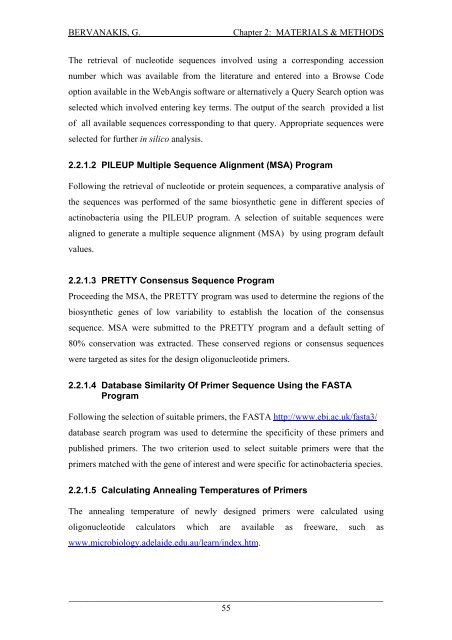Detection and Expression of Biosynthetic Genes in Actinobacteria ...
Detection and Expression of Biosynthetic Genes in Actinobacteria ...
Detection and Expression of Biosynthetic Genes in Actinobacteria ...
You also want an ePaper? Increase the reach of your titles
YUMPU automatically turns print PDFs into web optimized ePapers that Google loves.
BERVANAKIS, G.Chapter 2: MATERIALS & METHODSThe retrieval <strong>of</strong> nucleotide sequences <strong>in</strong>volved us<strong>in</strong>g a correspond<strong>in</strong>g accessionnumber which was available from the literature <strong>and</strong> entered <strong>in</strong>to a Browse Codeoption available <strong>in</strong> the WebAngis s<strong>of</strong>tware or alternatively a Query Search option wasselected which <strong>in</strong>volved enter<strong>in</strong>g key terms. The output <strong>of</strong> the search provided a list<strong>of</strong> all available sequences corresspond<strong>in</strong>g to that query. Appropriate sequences wereselected for further <strong>in</strong> silico analysis.2.2.1.2 PILEUP Multiple Sequence Alignment (MSA) ProgramFollow<strong>in</strong>g the retrieval <strong>of</strong> nucleotide or prote<strong>in</strong> sequences, a comparative analysis <strong>of</strong>the sequences was performed <strong>of</strong> the same biosynthetic gene <strong>in</strong> different species <strong>of</strong>act<strong>in</strong>obacteria us<strong>in</strong>g the PILEUP program. A selection <strong>of</strong> suitable sequences werealigned to generate a multiple sequence alignment (MSA) by us<strong>in</strong>g program defaultvalues.2.2.1.3 PRETTY Consensus Sequence ProgramProceed<strong>in</strong>g the MSA, the PRETTY program was used to determ<strong>in</strong>e the regions <strong>of</strong> thebiosynthetic genes <strong>of</strong> low variability to establish the location <strong>of</strong> the consensussequence. MSA were submitted to the PRETTY program <strong>and</strong> a default sett<strong>in</strong>g <strong>of</strong>80% conservation was extracted. These conserved regions or consensus sequenceswere targeted as sites for the design oligonucleotide primers.2.2.1.4 Database Similarity Of Primer Sequence Us<strong>in</strong>g the FASTAProgramFollow<strong>in</strong>g the selection <strong>of</strong> suitable primers, the FASTA http://www.ebi.ac.uk/fasta3/database search program was used to determ<strong>in</strong>e the specificity <strong>of</strong> these primers <strong>and</strong>published primers. The two criterion used to select suitable primers were that theprimers matched with the gene <strong>of</strong> <strong>in</strong>terest <strong>and</strong> were specific for act<strong>in</strong>obacteria species.2.2.1.5 Calculat<strong>in</strong>g Anneal<strong>in</strong>g Temperatures <strong>of</strong> PrimersThe anneal<strong>in</strong>g temperature <strong>of</strong> newly designed primers were calculated us<strong>in</strong>goligonucleotide calculators which are available as freeware, such aswww.microbiology.adelaide.edu.au/learn/<strong>in</strong>dex.htm._____________________________________________________________________55















